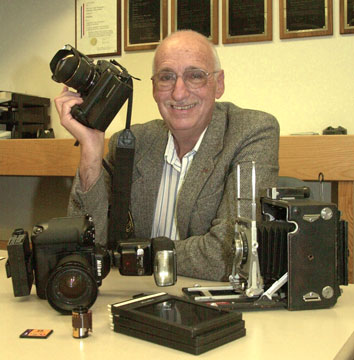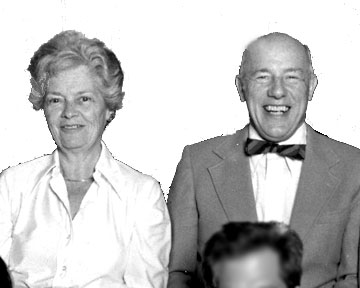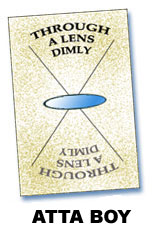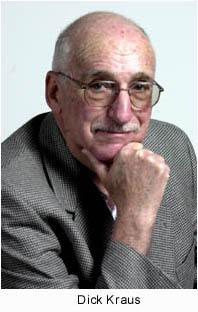PROLOGUE
I have often said that my early career as a staff photographer took
place in a context that could only be described
as Runyonesque. I am, of course, referring to the renowned newsman,
author and screenplay writer, Damon Runyon. He was born in
1884 and died in 1946. His stories were peopled with odd-ball characters,
the most well known of whom were the gamblers and minor hoods in the
stage play, which later became the movie, "Guys
And Dolls."
As
a newspaper photographer from the 1960's through 2002, I met
many a character who fit the Runyon mold. Most of them were
my associates at Newsday (Long Island, NY).
Over
the next few months, I will introduce you to them. In many
instances, I have changed names in the fervent hope that I
not be thrashed for having exposed their idiosyncracies to
the world. It is not my intent to ridicule or criticize anyone.
The antics and the events about which I write did truly take
place. Time may have dimmed the exact dialogs but I write these
journals depicting these people as accurately as humanly possible.
I hope that you will find them as interesting and as zany as
did I.
THROUGH
A LENS DIMLY
ATTA
BOY
By Dick Kraus
Newsday (LI, NY) Staff Photographer (retired)
We really looked forward to his “Atta Boy’s;” especially
we newer shooters. It was a sign from above that we were doing
ok. Web was pretty good about complimenting our best efforts to
come up with photos that would draw the reader’s attention
to the page. Web was Harvey Weber and he was Director of Photography
at Newsday when he hired me in 1960. He was trying to drag our
burgeoning photo department into the 20th Century; weaning us from
the old standard 4 X 5 Speed Graphic Press Camera to the newer,
more modern and versatile 35mm format.

| The author showing the 4
X 5 Speed Graphic with film holders, on right. That's
a 35mm film camera at bottom left and a digital in
his hand. |
|
His attitude was that newspapers were a word man’s business but we could
earn our daily bread if we came up with relevant photos that would keep the reader
from turning the page. Given the mundane kind of photo assignments we got, it
was no easy task to fulfill his wishes. He knew that and showed his appreciation
by tearing good shots out of the paper and scrawling across them in red grease
pencil, ”ATTA BOY. HAW.” That “HAW” wasn’t
a horselaugh. It was his initials. He would shove it into your mailbox and
we
collected them
like campaign ribbons.
By the same token, we sometimes found another kind of note in our boxes. “SEE
ME! HAW.” Life in Web’s Photo Department wasn’t all sunshine
and roses. “SEE ME! HAW” meant you were expected to drop by his desk
at the first available opportunity, whereupon you would receive an ass chewing
for not doing a better job on some assignment. There were no alibis allowed.
Web had cut his teeth with a camera on the street and he knew all the excuses.
It behooved you to listen to his chiding and learn a lesson from it. I mean,
the man was an excellent photographer and you could really learn news photography
from him.
|
One his
first jobs, after WWII was in Life Magazine’s darkroom.
He had some great anecdotes about some of those storied Life photographers.
One, in particular, was a woman who had attained stardom in her
field. She was admired by many, but such was not the case in
the darkroom.
Web told us that whenever a shipment of her film arrived at the
lab, the techs knew they were in for an ordeal. She never metered
her exposures
and in order to ensure that she had an image on the film, she would
over-expose her shots to the point that during the enlargements,
the techs would put a brick on the foot pedal controlling the
enlarger
light, and would go out for a smoke. Anyway, he came to Newsday
soon after, as a shooter, and a damned good one, at that. So,
most of us
stood there and took our lumps and we did learn and became better
photographers for it all. And, it wasn’t long before you
got your next “ATTA
BOY”
Web had enlisted in the US Army just prior to World War II and had
gotten into the Signal Corps as a photographer. When war broke out,
he went to OCS (Officers Candidate School) and became an officer.
He did duty in Europe and photographed the horrors of the Nazi concentration
camps when they were liberated by the Allies.
He stayed in the Army Reserves and eventually rose to the rank of
Colonel. He was a Lt. Colonel while he was running the Newsday Photo
Dept. and
sometimes he ran it like an Army Command. I had just finished a four-year
tour of duty in the US Navy and thought I was used to the military
form of meting out orders. But, I was a bit non-plused by his manner
of marshaling us all together at the end of a shift; lining us up
and dressing down the troops.
“ You’re getting lazy,” he would bark. “Your darkroom
work habits are getting sloppy. The accepted development procedure is to lift
the developing cans and give them a turn every 30 seconds. (There were no film
processing machines in our lab, back then.) I’ve seen you people shake
the goddam can like a cocktail shaker for 30 seconds and then not touch it
again until the buzzer rings. Ya gotta get on the stick.”
He would march back and forth in front of the line of photographers
like a Napoleon bawling out his army. Truth be told, he was very
short and most of us towered over him. At least he didn’t stick his
hand in his shirtfront.
As I said, I was non-plused. I couldn’t understand why he
was yelling at me. I took this sort of thing very personally I
broached
the subject with his deputy, Max Heine.
“ Why is he on my case, like that?” I asked. “I really take
pains to soup my film according to established procedures. So, why the Hell
is he yelling at me?”
Good old Max had a perfect answer. “He’s not yelling at
you, Kraus. Remember, he’s an army Lt. Col. That’s the
way they do it in the Army to keep the troops on their toes. They line
everyone up and fire broadsides at them. Eventually, one of those scattershots
will have some relevance for you. And, you’ll know when that
happens. So, don’t be so bloody thin skinned.”
As a matter of fact, Web was perfectly correct in his assessment
of our darkroom habits. One day, while we were all out on assignment,
he took his Leica and a tripod and went across the street to our
parking
lot. He snapped on a 35mm lens and mounted the camera on his tripod.
He framed a shot looking down a row of parked cars. Taking accurate
readings with his hand held exposure meter (Oh yes, children. There
were no automated exposures or built in meters back then) he ran
off a half a dozen frames. He reloaded with a fresh roll and did
the same
thing. When he had enough exposed rolls, he packed up and came back
to the department to wait. As each photographer came back from his
assignment, Web hand him one of his rolls and asked if the photographer
would put that roll through with his own. We did as we were asked
and Web collected each roll without a word and cut it up and sleeved
it.
He marked each sleeve with the name of the man who processed it and
when the last roll was collected, he called us over to the light
table and displayed the assortment.
“ I’m tired of flapping my gums about sloppy darkroom work,” he
said. “I asked everyone to run a roll of film that I shot, when they
developed their own work. Now step over here and take a good look.”
No two rolls looked the same, even thought each contained the same
subject matter and had been meticulously exposed. Some looked two
stops underexposed while some went two stops over. Some were right on the
money, compared to the one roll that Web, himself, developed. I was
happy to see that mine was one of those. Anyway, the Colonel had
made his point and the sloppy darkroom problem went away. At least for a
while.
I don’t know if he was as casual in his social contacts with his Army underlings
as he was with his photo staff at Newsday. You know; that non-fraternization
of officers with enlisted men thing. At Newsday, he was a party animal. Web encouraged
us to socialize. He and his lovely wife, Maddie, opened up their home to all
of us on more than one occasion. The photographers and their wives were treated
to barbeques and cocktail parties. We would reciprocate at our homes. Newsday
was also very generous with company parties and our department would always sit
together.
|

| Maddie Weber and her husband,
Harvey taken at Web's retirement party in 1979. |
|
When Web
was handed leadership of the Photo Staff in 1958, he inherited
a department of old timers who were pretty set in their ways. They
were seasoned photographers from the old school who were wedded
to their big press cameras and not inclined to accept the change
to
the 35mm format espoused by their new leader. But, undaunted, Web
rose
to the challenge, and while the older guys may not have risen to
the point where they could utilize the full potential inherent
with more
versatile and modern cameras, he was able to improve their work.
One of his techniques was the very clever use of friendly competition
between
the old staff and the younger men that he began to hire. We were
separated into two groups. You were either a “Mature Master,” or
a “Snot Nose Kid.” Each group strove to out-shoot the
other and garner the most “Atta Boys.” And he encouraged
all of us to learn from one another. The “Mature Masters” taught
us newbies the street smarts required to be successful out in the
real world. The “Snot Nose Kids” taught the old guys
how to take advantage of the new equipment and radical new photographic
techniques.
All of this created a very cohesive staff.
We were still a small staff, as far as New York newspapers went,
and if more than one shooter was assigned to a story, you know
it had to
be a major event. Whenever that happened, Web always cautioned
each of us that he had better see the other photographer in the
other
guy’s
shots. In other words, he didn’t want his shooters standing next
to one another, getting the same shots. This was a common bad habit
among news photographers. We all wanted to stand near our associates
so that we could gossip. But, that resulted in each of us coming back
with similar photos. Why waste the manpower for that? Under Weber,
one of us might work with a wide angle lens to get the broad view while
the other would have a long lens attached and would concentrate on
close-ups. If it were something like a court case where the person
we were after had a choice of exits to elude the media, we would work
out a plan to cover as many contingencies as possible. We often out-shot
the competition even though we might have been outnumbered. Web repeated
his order that we treat the wire photographers as members of our own
staff and not stand with them. Rather, if AP or UPI were on the scene,
they would cover the “safe” shot. We were free to look
for a better angle or to try something off the wall to come back with
something better than any one else. There were never any repercussions
if the wire shot was the best and was used instead of a staffer’s
photo. It’s always a crap shoot, and sometimes you win and sometimes
you don’t. Nor did we feel cheated if our shot didn’t
make it. Web taught us that by acting in this manner, we were better
serving
the paper and our readers by having the best shot published.
He was a great storyteller and a good listener. Whenever a group
of us was able to get together at lunch or dinner, he would get
us going
by relating some off-the-wall event from his past and we would
contribute our own outrageous stories. He would laugh along with
us at some
of the incredible stories being told. His laugh was a gutteral “Wutsa
wutsa wutsa” that we would imitate at parties. And he often
said that we should sit down, one day, with a keg of beer and a
tape recorder
and commit these stories for posterity.
“ No one would ever believe them to be possible,” he would say. “And
after we’re gone, these stories will be lost for ever.”
He was right, of course. Which is why I have made an effort to make
them available here, on The Digital Journalist, in my series “Through
a Lens, Dimly.”
And, I dedicate them to my friend and mentor, the late Harvey A.
Weber.
Atta boy, Web. Wutsa wutsa wutsa.
Dick Kraus
http://www.newsday.com
newspix@optonline.net



